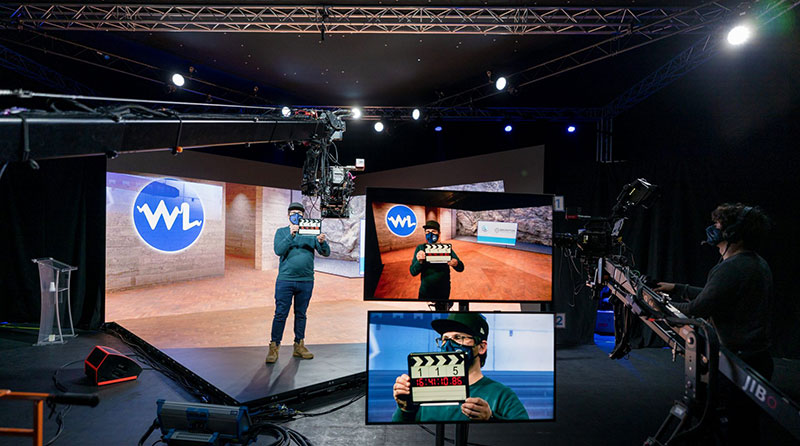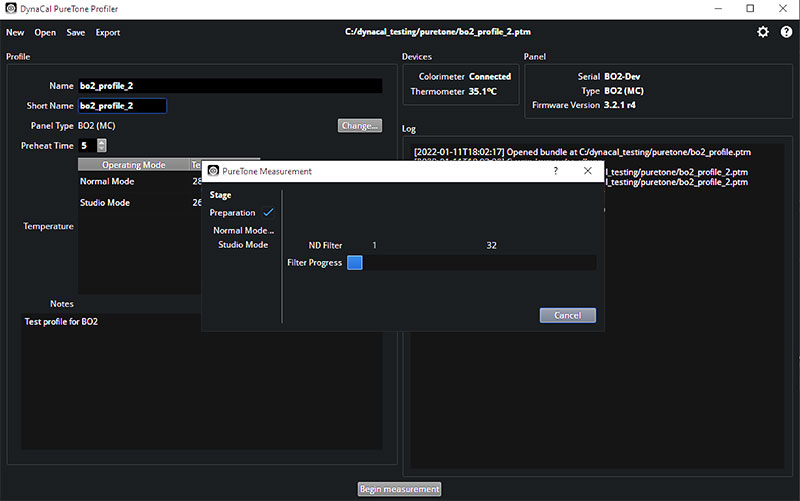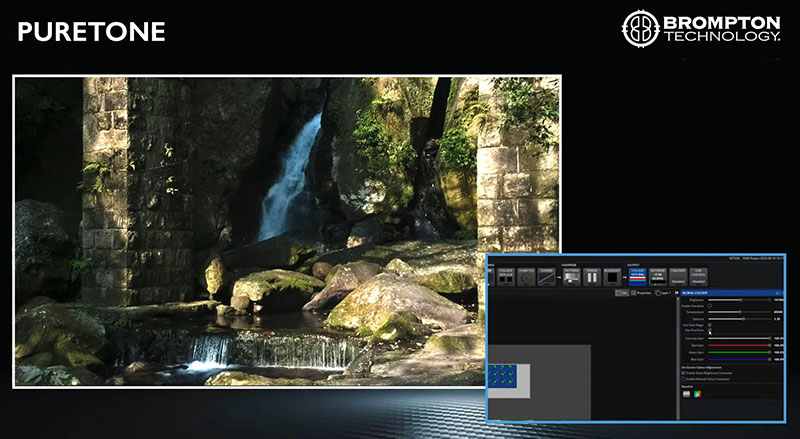Brompton’s Tessera v3.3 image processing software helps productions optimise the performance of LED panels used on set and in live scenarios.
 a
a
The new v3.3 software for Brompton Technology’s Tessera image processors helps productions optimise the performance of LED panels used on set and in live scenarios. New features include Operating Modes, and Per-Batch PureTone. Tessera models SX40 and S8 now also have a preset to support the ACES AP1 colour space, as used by the ACEScg linear encoding in AP1 primaries for rendering and compositing. Also, Brompton has added support for the Mo-Sys StarTracker camera tracking system when using panels fitted with the Tessera R2 or new Tessera R2+ receiver card and an SX40 or S8 processor with Frame Remapping. (More information below.)
The new Tessera R2+ card has the same SO-DIMM form-factor as the R2, made for high resolution LED fixtures. R2+ is backwards-compatible with all existing R2-based panel designs, and adds extra data pins and functionality supporting new LED drivers in order to maintain support for many panel types.
Selectable Operating Modes
Normally, when FAE (field applications engineering) teams work with panel manufacturers to create a panel configuration, certain compromises must be made between different aspects of visual performance. Pushing for faster refresh rates may mean reducing PWM (Pulse Width Modulation) bit depth, for example, while increasing maximum brightness may affect low brightness performance. Even though panel manufacturers are seeking to find a good balance, currently only a one-size-fits-all configuration is applied for the life of the panel.
“This presents a real challenge if you need to re-use LED panels across various scenarios, all of which require prioritising different aspects of visual performance. For instance, you may require maximum brightness for an outdoor live event, but need the highest effective refresh rate to optimise performance with certain camera types in a studio,” said Brompton CTO, Chris Deighton. “With the Operating Modes feature available in Tessera version 3.3 onwards, both scenarios can benefit from the best possible panel performance.”

Thus, a single panel type is now able to support multiple Operating Modes, each with a slightly different configuration for the panel and each prioritising different aspects of visual performance, including not only brightness and refresh rate as mentioned above but also maximum frame rate and bit depth, among others.
Brompton’s engineers can also create specialty Operating Modes by working alongside panel manufacturers. Once activated, users can switch their panels instantly between Operating Modes via the processor, depending on the requirement of each event or project, giving them much greater control over the results from their LED panels without having to purchase or rent new ones.
Per-Batch PureTone Calibration
Rental companies are familiar with the challenge of matching different batches of LED panels. Although of the same type, calibrated to the same brightness, colour temperature and colour targets, a new batch of LED panels can still look noticeably different when displaying real world content. Typical causes are differences in the inherently non-linear effects of different batches of LED or driver chips. LEDs are non-linear devices in which the relationship between the input and output varies according to the current and/or voltage.
Brompton’s PureTone feature was developed to correct this behaviour. In the new Tessera v3.3 software, PureTone has been extended to allow each individual batch of panels to be measured separately to generate a PureTone profile specific to that batch. To create a profile, a PureTone profiling kit is required that incorporates a sensitive colorimeter. A single LED panel is measured within a dark room to generate the profile, which can then be used with all the panels in that particular batch.

“With the new PureTone feature, our customers and panel manufacturers can correct the non-linearity for each batch of panels, ensuring neutral greyscales and accurate luminance performance in all Operating Modes,” Chris said. “Matching different batches of LEDs becomes much easier. PureTone is also really useful in film and broadcast work, where screens are often run at much lower brightness to match camera exposures but still need to maintain neutral grayscales and accurate colour reproduction.”
ACEScg Support
Contibuting to workflows for virtual production, the Tessera SX40 and S8 now have a preset to support the ACES AP1 primaries used in the ACEScg colour space that CG artists are using more often now. ACEScg is scene-referred, or linear, with a wide colour gamut and very high dynamic range, avoiding the need for a colour space conversion in the source device.
ACES AP1 will be automatically recognised by the processor when received over HDMI 2.0. Alternatively, it may be manually selected on the processor. The user can also reference the ACES AP1 colour gamut when using Brompton’s dynamic calibration tools.
“By supporting the ACEScg colour space, we can make sure that users working in that space can now output it directly without an unnecessary colour space conversion,” said Chris. “In some cases, the fact that the source needs to do that conversion may result in a loss of precision or clipping colours. We wanted to simplify that process and ensure users who really care about their colour precision can further speed up their workflow without undue concern.”
Remapping Digital Tracking Markers
Brompton has added support for the Mo-Sys camera tracking system, StarTracker, when using Tessera R2-based panels together with Tessera SX40 or S8 LED processors and Frame Remapping.

Frame Remapping is interesting and very useful. It allows the cameras in a multi camera shoot to record different digital backgrounds on the same LED panel, in one take. To people on set, the background images will appear super-imposed, but the cameras’ and panels’ refresh rates are coordinated so that the cameras each see only one of the backgrounds. A production can emulate the different perspectives captured in a real multi-cam shoot; or record two different backgrounds during a single take and then choose between them in post; or shoot versions of a take both with a rendered background and with a green screen for compositing in post.
In this case, one of the backgrounds can display digital tracking markers. “Accurately tracking the position of the camera is critical to many virtual production and xR applications,” Chris said. “Although many different systems achieve this, a common approach has been using visible markers, which can be challenging within an LED volume, especially one with an LED ceiling. This can now be resolved by displaying suitable markers on the LED itself and using Frame Remapping to avoid extra work on set or in post.”
The markers are overlaid on the video content being displayed, while the Frame Remapping feature only displays the markers on output frames that are not visible to the main camera, ensuring they will never appear in shot or in reflections. The markers are automatically generated, with the ability to configure the colour and size of the markers from within the processor UI. www.bromptontech.com




